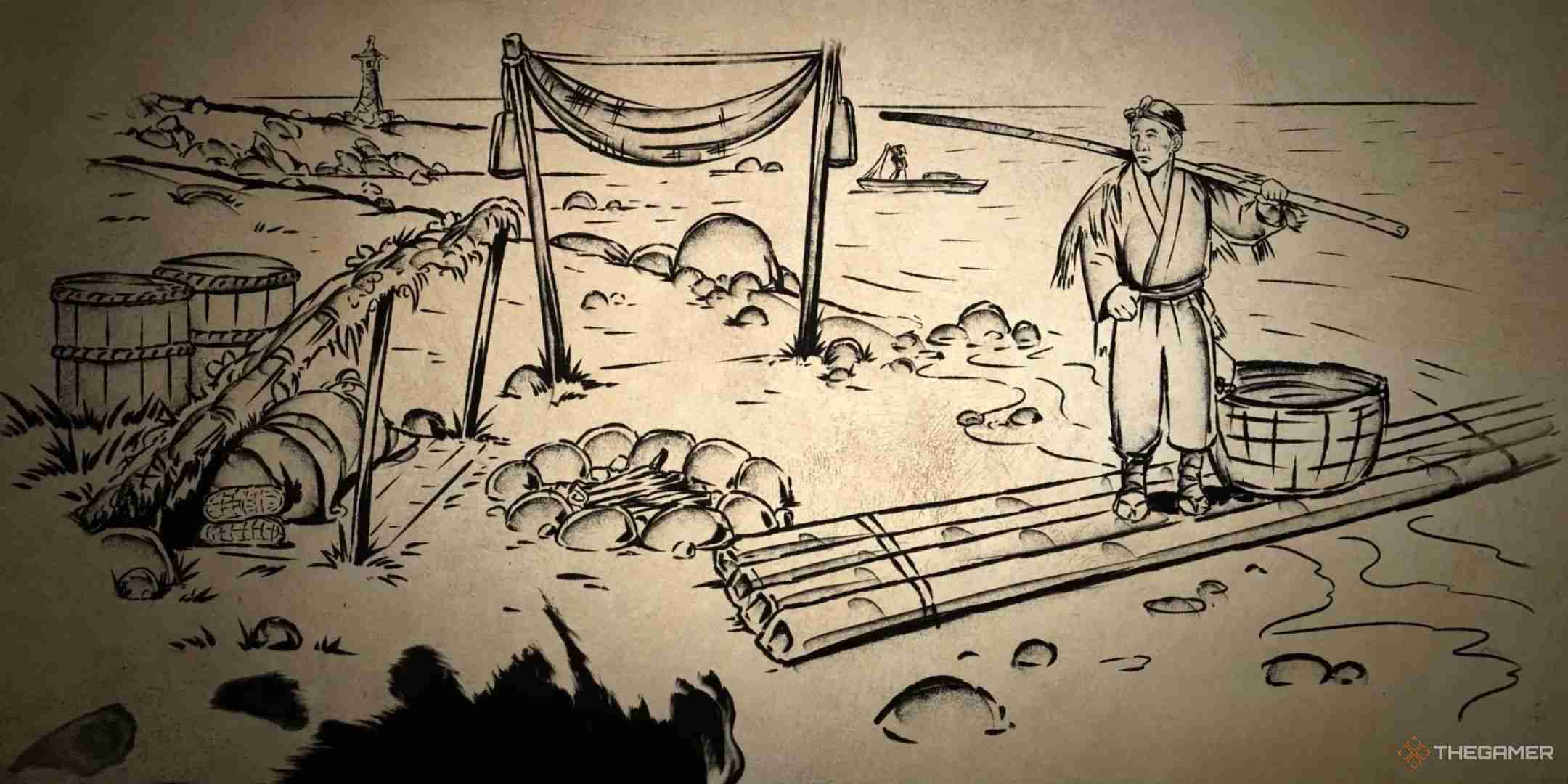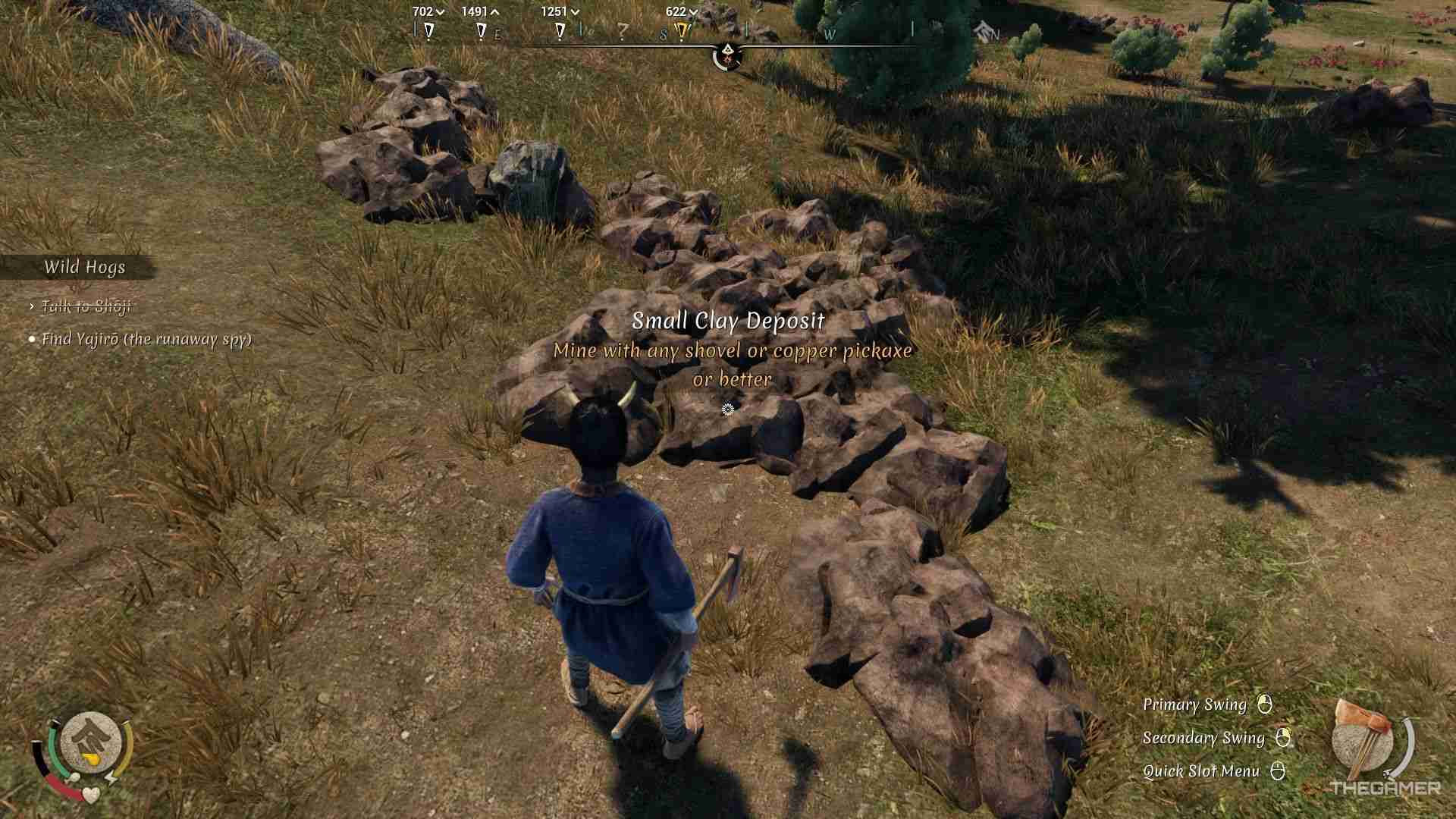Sengoku Dynasty: Where To Find Clay
One of the many key resources in Sengoku Dynasty is clay. This critical mineral is fairly abundant, as long as you know where to look. Once you have a place to dig and the right tools, you'll be able to use clay for both farming and crafting to improve the lives of your villagers.

Being able to get and store clay makes a great early-game goal when you're just starting out. If you're a bit lost in the open world of the Nata Valley and could use some guidance in filling your stockpiles with clay, read on.
Where To Find Clay In Sengoku Dynasty

Clay can be found in large quantities along rivers, particularly the one east of your starting location at the ruins of Sosogi. It's most abundant directly on the river banks, but you can sometimes find it a little further out from the water as well. Don't expect to find any clay in areas where there isn't any fresh water, though.
Look for large brown mounds of earth piled up near the water. In the winter, these will be covered over with snow, but you'll still be able to recognize the lumpy texture that's different from the regular ground. When in doubt, you can always approach the mounds; the game's usual text will pop up indicating that you've found a mineral deposit to mine.
How To Mine Clay In Sengoku Dynasty

Mining clay from a deposit in the ground requires either a shovel of any kind or a pickax made of any material other than stone. Both can be crafted in a Workshop, so be sure to build one if you intend to head out in search of clay.
You can stack up to 25 units of clay in a single inventory space while carrying it, so it can fill up your inventory quickly if you dig out too much too quickly. You generally don't need a lot of clay for most projects, unless you're building a large field for water crops like rice, so don't overdo it.

What Is Clay Used For In Sengoku Dynasty?

Clay is primarily used in the construction of smelting and metalworking equipment, as well as charcoal kilns to turn firewood into more-efficient charcoal. If you're planning to expand your village to start forging your own weapons and armor, you'll want to have clay in reserve to make the necessary work stations.
Clay is also used for making water crop fields. Unlike land crop fields, these fields spend much of the planting season flooded to allow the plants to grow, which the clay helps facilitate since it's less absorbent than soil. Rice is an important crop that you'll use water crop fields for.
Each section of a water field costs one clay and one stone.

-
 Dragon Age: The Veilguard - Lives Spared WalkthroughWith the numerous available quests in Dragon Age: The Veilguard, you will often find yourself distracted from the main story, spending time helping yo...Game Published on 2024-11-21
Dragon Age: The Veilguard - Lives Spared WalkthroughWith the numerous available quests in Dragon Age: The Veilguard, you will often find yourself distracted from the main story, spending time helping yo...Game Published on 2024-11-21 -
 Throne and Liberty: World Event timetable and how to find out when Morokai and other world bosses spawnYou may have noticed, there are loads of world events and world bosses in Throne and Liberty! Some of them spawn every hour or two, but there are a fe...Game Published on 2024-11-21
Throne and Liberty: World Event timetable and how to find out when Morokai and other world bosses spawnYou may have noticed, there are loads of world events and world bosses in Throne and Liberty! Some of them spawn every hour or two, but there are a fe...Game Published on 2024-11-21 -
 Sengoku Dynasty: Where To Find ClayOne of the many key resources in Sengoku Dynasty is clay. This critical mineral is fairly abundant, as long as you know where to look. Once you have a...Game Published on 2024-11-20
Sengoku Dynasty: Where To Find ClayOne of the many key resources in Sengoku Dynasty is clay. This critical mineral is fairly abundant, as long as you know where to look. Once you have a...Game Published on 2024-11-20 -
 Dragon Age: The Veilguard - Should You Punch The First Warden At The Seige Of Weisshaupt?During The Siege of Weisshaupt, one of Dragon Age: The Veilguard's most intense missions, the Rook and their party will battle their way to the Wa...Game Published on 2024-11-20
Dragon Age: The Veilguard - Should You Punch The First Warden At The Seige Of Weisshaupt?During The Siege of Weisshaupt, one of Dragon Age: The Veilguard's most intense missions, the Rook and their party will battle their way to the Wa...Game Published on 2024-11-20 -
 Monopoly Go: Peg-E Sticker Drop Rewards Guide (November 6-10)If you noticed that brand new kind of sticker pack added today in Monopoly Go, you're likely...Game Published on 2024-11-19
Monopoly Go: Peg-E Sticker Drop Rewards Guide (November 6-10)If you noticed that brand new kind of sticker pack added today in Monopoly Go, you're likely...Game Published on 2024-11-19 -
 Brighter Shores: How To Enchant EquipmentBrighter Shores gently tosses you into the quaint town of Hopeport, where you'll be able to explore, complete quests, and defeat enemies. Along th...Game Published on 2024-11-19
Brighter Shores: How To Enchant EquipmentBrighter Shores gently tosses you into the quaint town of Hopeport, where you'll be able to explore, complete quests, and defeat enemies. Along th...Game Published on 2024-11-19 -
 How to get flair in Pokémon TCG PocketIf you have lots of duplicate cards in Pokémon TCG Pocket, you can spruce up cards with flair. These cosmetic effects are entirely optional, and just ...Game Published on 2024-11-19
How to get flair in Pokémon TCG PocketIf you have lots of duplicate cards in Pokémon TCG Pocket, you can spruce up cards with flair. These cosmetic effects are entirely optional, and just ...Game Published on 2024-11-19 -
 Call Of Duty: Black Ops 6 - How To Unlock Every Zombies Weapon Camo...Game Published on 2024-11-19
Call Of Duty: Black Ops 6 - How To Unlock Every Zombies Weapon Camo...Game Published on 2024-11-19 -
 The best Apple Arcade games to play in 2024Update: New games are being added to Apple Arcade all the time, so we've updated this list of the best Apple Arcade games with some games worth checki...Game Published on 2024-11-19
The best Apple Arcade games to play in 2024Update: New games are being added to Apple Arcade all the time, so we've updated this list of the best Apple Arcade games with some games worth checki...Game Published on 2024-11-19 -
 Brighter Shores: The Lost Shipment Quest Walkthrough'The Lost Shipment' is an early side quest in Brighter Shores, but don't let that fool you - as with most Brighter Shores quests, it's...Game Published on 2024-11-19
Brighter Shores: The Lost Shipment Quest Walkthrough'The Lost Shipment' is an early side quest in Brighter Shores, but don't let that fool you - as with most Brighter Shores quests, it's...Game Published on 2024-11-19 -
 The Sims 4: Life & Death - How To Keep A Pet CrowIf you're looking for a freaky familiar in The Sims 4: Life & Death, then consider getting y...Game Published on 2024-11-19
The Sims 4: Life & Death - How To Keep A Pet CrowIf you're looking for a freaky familiar in The Sims 4: Life & Death, then consider getting y...Game Published on 2024-11-19 -
 Planet Coaster 2: Path GuideAlthough creating your own coasters and flumes in Planet Coaster 2 is complicated, sometimes it's building paths around your park that gives you t...Game Published on 2024-11-18
Planet Coaster 2: Path GuideAlthough creating your own coasters and flumes in Planet Coaster 2 is complicated, sometimes it's building paths around your park that gives you t...Game Published on 2024-11-18
Study Chinese
- 1 How do you say "walk" in Chinese? 走路 Chinese pronunciation, 走路 Chinese learning
- 2 How do you say "take a plane" in Chinese? 坐飞机 Chinese pronunciation, 坐飞机 Chinese learning
- 3 How do you say "take a train" in Chinese? 坐火车 Chinese pronunciation, 坐火车 Chinese learning
- 4 How do you say "take a bus" in Chinese? 坐车 Chinese pronunciation, 坐车 Chinese learning
- 5 How to say drive in Chinese? 开车 Chinese pronunciation, 开车 Chinese learning
- 6 How do you say swimming in Chinese? 游泳 Chinese pronunciation, 游泳 Chinese learning
- 7 How do you say ride a bicycle in Chinese? 骑自行车 Chinese pronunciation, 骑自行车 Chinese learning
- 8 How do you say hello in Chinese? 你好Chinese pronunciation, 你好Chinese learning
- 9 How do you say thank you in Chinese? 谢谢Chinese pronunciation, 谢谢Chinese learning
- 10 How to say goodbye in Chinese? 再见Chinese pronunciation, 再见Chinese learning

























